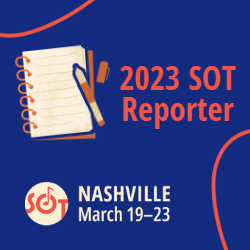
Gene therapy research using therapeutic genes has been an area of interest in recent years. Ongoing studies focus on developing therapeutic genes for inherited and acquired ocular diseases. The eye is small and requires few copies of the gene, making it a good candidate for gene therapy. Following the approval in December 2017 of voretigene neparvovec-rzyl (Luxturna), which is a treatment for mutations in the gene RPE65, multiple clinical trials are being conducted targeting ocular diseases. The Symposium Session, “Opening Our Eyes: Ocular Gene Therapies from Theory to Practice,” connects ocular toxicologists to development strategies, clinical trial study designs, approval and use of ocular gene therapies, and the challenges faced by ongoing studies. Dr. Kenneth Schafer of Greenfield Pathology Services and Dr. Helen Booler of Novartis Institutes for BioMedical Research chaired and co-chaired the session.
Dr. Jacquiline Brassard led the first talk on nonclinical considerations in the development of ocular gene therapies. Delivery of therapeutic genes requires the use of vectors. These could be non-viral or viral, with the latter being more common. Comparing the three major viral vectors used, the adeno-associated virus is the most common but is limited by small packaging capacity and required repeated dosing. Other viral vectors, like lentiviruses and adenovirus vectors, although having large cargo capacity are not utilized due to the risk of mutation, oncogenesis, and antigenicity. The development of therapies using second-generation vectors provides tissue specificity, transduction, and improved efficacy.
The process of preclinical development for ocular gene therapies and US Food and Drug Administration (US FDA) regulations was discussed by Dr. Eva Andres-Mateos and Dr. Rondine Allen, respectively. The goal of this thorough process is to improve efficacy, toxicology studies (safety), and assess risk-benefit. In general, during this process, a decision must be made on cargo (therapeutic gene), packaging, and route of administration (ROA). One major part of the early preclinical process is the selection and optimization of the ROA. The three main ROAs are intravitreal, suprachoroidal, and subretinal injection. The choice of ROA is dependent on the target cells and vector used. Early identification of potential challenges is essential. The choice of the model, bioanalytical assay, and dose must be Good Laboratory Practice–compliant using the same manufacturing process to be used in the clinics. During the development of models and testing, the immune privilege of the eye should be considered. The ROA and vector used can elicit an immune response, annulling the effect of the therapeutic gene. It is vital to remember that regulatory testing strategies for gene therapy products are flexible. Hence, “no one size fits all.” Preclinical testing programs should be science-based, include data on the translation of benefit-risk to humans, involve the use of state-of-the-art technology and methods, and have a judicious use of animals.
Just before the extensive panel discussion involving questions from the audience, Dr. Aaron Osborne touched on maximizing benefits and risks in ocular adeno-associated virus gene therapy, incorporating lessons learned from ongoing clinical trials. The focus of current studies in ocular gene therapy is evading immune response following treatment and the use of non-viral vectors for therapeutic gene delivery.
Ocular gene therapy is an emerging field that promises a longer-lasting treatment for rare/common inherited and acquired ocular disorders. Toxicologists play a unique role in this promising and exciting field, transforming lives using revolutionary therapy.
Here are some useful links to available resources:
This blog reports on the Symposium Session titled “Opening Our Eyes: Ocular Gene Therapies from Theory to Practice” that was held during the 2023 SOT Annual Meeting and ToxExpo. An on-demand recording of this session is available for meeting registrants on the SOT Online Planner and SOT Event App.
This blog was prepared by an SOT Reporter and represents the views of the author. SOT Reporters are SOT members who volunteer to write about sessions and events in which they participate during the SOT Annual Meeting and ToxExpo. SOT does not propose or endorse any position by posting this article. If you are interested in participating in the SOT Reporter program in the future, please email SOT Headquarters.
#Communique:ScienceNews
#2023AnnualMeeting
#Communique:SOTNews
#SOTReporter